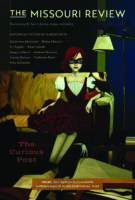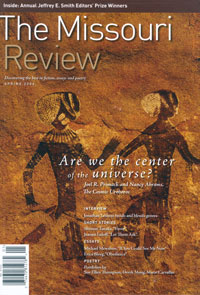Foreword | March 01, 2006
A Sense of Place
Speer Morgan
The start of our twenty-ninth year is marked by the beginning of The Missouri Review as a quarterly and by the winners of the Jeffrey E. Smith Editors’ Prize. The winners in all of the genres—poetry, nonfiction and fiction—are all first-time publications. This hasn’t happened in sixteen years of the contest, which confirms what we have lately suspected—that, if anything, there’s an increasing amount of writing talent waiting to be discovered in this country today. Interestingly, two of the contest winners are writing from experiences that they had as Peace Corps volunteers.
In her essay “Obedience,” Erica Bleeg struggles to understand differences between cultural attitudes in Africa and America. Joanna Luloff’s story “Let Them Ask” is about not just Sri Lankan culture but also the cruelty and sincerity of childhood, as school girls turn against one of their own for not maintaining a feminine mask. Shimon Tanaka’s story “Favor” concerns the miracle and idiosyncrasies of a lifelong friendship, to some extent paralleling the oddity of existence itself—with its obligations and not wholly pleasant chance and circumstance.
In his memoir “If You Could See Me Now,” taken from an upcoming book of the same title, to be published in April by Unbridled Books, Michael Mewshaw tells the fascinating story of a complicated early love and of the woman’s choice to put up an illegitimate child (by another man) for adoption. In later life, the mother served in public roles, including that of a presidential adviser, and the daughter would seek out her parents.
This issue also includes James Schiff’s excellent interview with Jonathan Lethem, author of books including The Fortress of Solitude, Girl in Landscape, and Motherless Brooklyn, winner of the National Book Critics Circle Award. Lethem reveals his lack of confidence as a young author, his commitment to learn how to write, as well as discussing his choice to work in an experimental style that bends and conflates fantasy, absurdist and pop writing.
“The Cosmic Uroboros” by Joel R. Primack and Nancy Ellen Abrams, taken from their upcoming book A View from the Center of the Universe (to be published by Riverhead Books) is about today’s cosmology, which they depict as surprisingly graspable and established. Primack is one of the scientists behind “Cold Dark Matter” theory, one of the central ideas in current observational and theoretical cosmology. Among the intriguing points the authors make is that while at times we may imagine ourselves to be specks in a too-vast-to-comprehend universe, humans are in fact fortunate winners in scale, being exactly the “right” size.
One of the major themes of this prize issue is winning not money or power but, more importantly, a sense of place and belonging. Understanding where one is, fitting in, finding roles, connecting with others and with the rest of nature—these are primordial themes not just in literature but in all of art.
# # #
Recently I was reading about the history of archaeological ideas concerning the earliest significant bodies of art, the portable and cave art of the Paleolithic Period. Early theorists portrayed such art as a way of thinking and feeling visually about the world and about nature, a kind of “doodling” about humans and their relationships to the rest of nature. Later theories became more complex, describing early human art as the possible tools of shamanism, initiation, religion and social organization. Interestingly, several recent archaeologists and anthropologists are effectively going back to a modified early view, saying that while we may surmise social or religious uses in some cases, there simply isn’t enough evidence to support meaningful conclusions.
For example, fifteen- to twenty-five-thousand-year-old Venus figurines have been found in widely dispersed places in Europe. Given their typically enlarged breasts and bellies, it is reasonable to speculate that they have something to do with fertility or reproduction. But disagreement about what the figurines represent, as well as contemporary awareness of the surprising variety in human behavior and ideas, makes today’s anthropologists wary about casually declaring that the Venus figurines are the tools of shamanism or fertility magic.
However, we can say with confidence that the art of the Magdalenian Period (16,000 to 10,000 B.C.), for example, is brimming with intriguing evidence of humans wondering about nature and their relationship with nature: portraits of animals, often in beautiful and graceful movement and intriguing symmetries, animals with “see-through” bodies in which their insides are revealed, animals and humans in hybrid forms, animals sometimes being hunted but more often not. This introspective approach emphasizes what is obvious about the art—that it represents the expanding capacity of humans to appreciate and speculate. In a sense, anthropologists are admitting that whatever its specific purposes may have been, early drawing, painting and sculpture is art, representing the human wonderment and large and inexact questioning that is at the nature of all artistic behavior.
Call it “doodling” or call it Paleolithic aestheticism, all of the arts—as these fine young writers show—are still very much about the same things: appreciation, awe, toned representations of who we are and what connects us.
—Speer Morgan
If you are a student, faculty member, or staff member at an institution whose library subscribes to Project Muse, you can read this piece and the full archives of the Missouri Review for free. Check this list to see if your library is a Project Muse subscriber.
Want to read more?
Subscribe TodaySEE THE ISSUE
SUGGESTED CONTENT

Features
Jan 08 2024
Foreword: Family Affairs
Family Affairs During the nineteenth century, observers from both sides of the Atlantic admired the relative looseness of American families while also criticizing a lack of multigenerational connectivity and… read more

Features
Dec 19 2023
Foreword: The Curious Past
The Curious Past The past is such a curious creature, To look her in the face A transport may reward us, Or a disgrace. – Emily Dickinson Jonathan Rosen’s… read more

Features
Jul 27 2023
Foreword: The New Realism
The New Realism I sometimes wonder what the dominant trend in literature is going to be called. Names for artistic periods and movements are hardly definitive, but they are useful… read more

